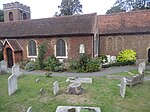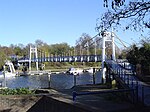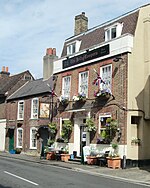Teddington Lifeboat Station
2002 establishments in EnglandLifeboat stations in LondonRiver ThamesTeddingtonTransport in the London Borough of Richmond upon Thames ... and 1 more
Use British English from November 2017

Teddington Lifeboat Station is a lifeboat station in Teddington, in west London, on the River Thames. It is one of the Royal National Lifeboat Institution (RNLI)'s newest lifeboat stations and is also one of the first to cover a river rather than estuarial waters or the sea. Teddington Lock is the highest tidal point on the Thames.
Excerpt from the Wikipedia article Teddington Lifeboat Station (License: CC BY-SA 3.0, Authors, Images).Teddington Lifeboat Station
Manor Road, London Strawberry Hill (London Borough of Richmond upon Thames)
Geographical coordinates (GPS) Address Nearby Places Show on map
Geographical coordinates (GPS)
| Latitude | Longitude |
|---|---|
| N 51.4309 ° | E -0.3259 ° |
Address
RNLI Shop
Manor Road
TW11 8BF London, Strawberry Hill (London Borough of Richmond upon Thames)
England, United Kingdom
Open on Google Maps










